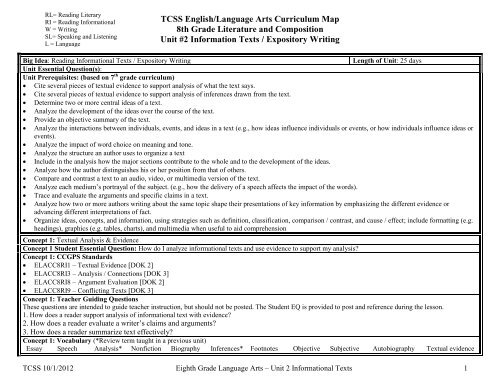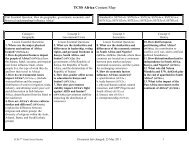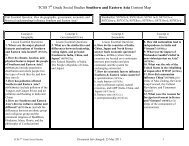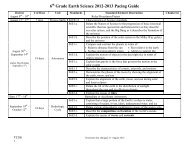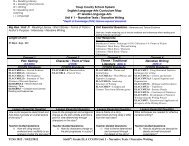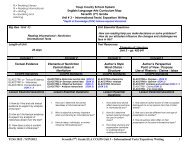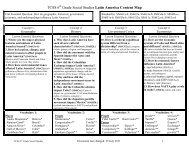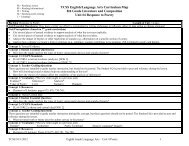TCSS English/Language Arts Curriculum Map 8th Grade Literature ...
TCSS English/Language Arts Curriculum Map 8th Grade Literature ...
TCSS English/Language Arts Curriculum Map 8th Grade Literature ...
You also want an ePaper? Increase the reach of your titles
YUMPU automatically turns print PDFs into web optimized ePapers that Google loves.
RL= Reading Literary<br />
RI = Reading Informational<br />
W = Writing<br />
SL= Speaking and Listening<br />
L = <strong>Language</strong><br />
<strong>TCSS</strong> <strong>English</strong>/<strong>Language</strong> <strong>Arts</strong> <strong>Curriculum</strong> <strong>Map</strong><br />
<strong>8th</strong> <strong>Grade</strong> <strong>Literature</strong> and Composition<br />
Unit #2 Information Texts / Expository Writing<br />
Big Idea: Reading Informational Texts / Expository Writing Length of Unit: 25 days<br />
Unit Essential Question(s):<br />
Unit Prerequisites: (based on 7 th grade curriculum)<br />
� Cite several pieces of textual evidence to support analysis of what the text says.<br />
� Cite several pieces of textual evidence to support analysis of inferences drawn from the text.<br />
� Determine two or more central ideas of a text.<br />
� Analyze the development of the ideas over the course of the text.<br />
� Provide an objective summary of the text.<br />
� Analyze the interactions between individuals, events, and ideas in a text (e.g., how ideas influence individuals or events, or how individuals influence ideas or<br />
events).<br />
� Analyze the impact of word choice on meaning and tone.<br />
� Analyze the structure an author uses to organize a text<br />
� Include in the analysis how the major sections contribute to the whole and to the development of the ideas.<br />
� Analyze how the author distinguishes his or her position from that of others.<br />
� Compare and contrast a text to an audio, video, or multimedia version of the text.<br />
� Analyze each medium’s portrayal of the subject. (e.g., how the delivery of a speech affects the impact of the words).<br />
� Trace and evaluate the arguments and specific claims in a text.<br />
� Analyze how two or more authors writing about the same topic shape their presentations of key information by emphasizing the different evidence or<br />
advancing different interpretations of fact.<br />
� Organize ideas, concepts, and information, using strategies such as definition, classification, comparison / contrast, and cause / effect; include formatting (e.g.<br />
headings), graphics (e.g. tables, charts), and multimedia when useful to aid comprehension<br />
Concept 1: Textual Analysis & Evidence<br />
Concept 1 Student Essential Question: How do I analyze informational texts and use evidence to support my analysis?<br />
Concept 1: CCGPS Standards<br />
� ELACC8RI1 – Textual Evidence [DOK 2]<br />
� ELACC8RI3 – Analysis / Connections [DOK 3]<br />
� ELACC8RI8 – Argument Evaluation [DOK 2]<br />
� ELACC8RI9 – Conflicting Texts [DOK 3]<br />
Concept 1: Teacher Guiding Questions<br />
These questions are intended to guide teacher instruction, but should not be posted. The Student EQ is provided to post and reference during the lesson.<br />
1. How does a reader support analysis of informational text with evidence?<br />
2. How does a reader evaluate a writer’s claims and arguments?<br />
3. How does a reader summarize text effectively?<br />
Concept 1: Vocabulary (*Review term taught in a previous unit)<br />
Essay Speech Analysis* Nonfiction Biography Inferences* Footnotes Objective Subjective Autobiography Textual evidence<br />
<strong>TCSS</strong> 10/1/2012 Eighth <strong>Grade</strong> <strong>Language</strong> <strong>Arts</strong> – Unit 2 Informational Texts 1
Concept 1: Resources<br />
� Elements of <strong>Literature</strong>: Informational Text Focus 108, 220, 330, 454, 564, 928; “What Reading Skills Help You to Understand Nonfiction?” 370; “What<br />
Skills Help You Read Informational Texts?” 602; “Evaluating a Summary” 455; Nonfiction Works / “Making Inferences 163, 833; “Analyzing Details” 31,<br />
389, 513, 525;“Making Connections” 179, 759; “Comparing Treatments 545; “Comparing Texts: Treatment, Scope, and Organization” 221; Paraphrasing a<br />
Text” 377, 703, 746; “Drawing Conclusions” 417, 427; Selections from Nonfiction –Collection 5, pp. 486-570; Reading for Life – Collection 6, pp. 598- 638<br />
� Teacher Resources – Holt Collection #5 – Nonfiction; Collection #6 – Reading for Life<br />
Concept 1: Performance Tasks<br />
� Teachers will use the Textbook resources and graphic organizers to help students analyze different texts. (DOK 4)<br />
� Analyze a reading selection and use evidence to support conclusions (DOK 4)<br />
Concept 2: Structure and Elements of Non-Fiction and Media<br />
Concept 2 Student Essential Question: How does an analysis of text structure and features help me identify the central idea of informational texts?<br />
Concept 2: CCGPS Standards<br />
� ELACC8RI2 – Central Idea [DOK 2/3]<br />
� ELACC8RI5 – Structure of Paragraphs [DOK 2/3]<br />
� ELACC8RI6 – Author’s Purpose and Point of View [DOK 2/3]<br />
� ELACC8RI7 – Various Media [DOK 2]<br />
Concept 2: Teacher Guiding Questions<br />
These questions are intended to guide teacher instruction during this concept, but these questions should not be posted. The Student EQ is provided to post and<br />
reference during the lesson.<br />
1. How do features/structures impact informational text effectiveness?<br />
2. How do particular sentences affect the development of key concepts?<br />
3. How does a reader determine the central idea of a text?<br />
Concept 2: Vocabulary (*Review term taught in a previous unit)<br />
Bias Structure Perspective Central Idea* Comparisons Bibliography<br />
Logical order Textual features Cause and Effect Conflicting evidence Problem and Solution Comparison and contrast<br />
Concept 2: Resources<br />
� Elements of <strong>Literature</strong> *Informational Skills – Structure of a Textbook – 109; Structure and Purpose of a Newspaper Article – 117; Speech and Structural<br />
Patterns – 525; Structure- 492; Cause and Effect Organization 331336-; Comparison and Contrast 337 -335<br />
� Elements of <strong>Literature</strong> – “Finding the Main Idea” 497; Making Generalizations 281; “Talking and Writing About Informational Documents” – 609; “Talking<br />
and Writing About Nonfiction” 495; Elements of Nonfiction – What is Nonfiction? (Includes main idea and purpose) pp. 487<br />
� Perspective – 499 (historical) Literary 55, 169, 283, 379, 383, 499, 723, 841, 846, 854, 859, 880, 889, 905 (Most of these have to do with reading literary, but<br />
some are adaptable to teaching author’s point of view and purpose<br />
� Informational Skills Review: Skimming and Scanning 625; Understanding graphics 639; Summary 455, 15<br />
� Previewing Informational Texts – 611; boldface 602; bulleted lists 602; graphics, 602, numbered lists 602, heads 603; subheads 602<br />
� Teacher Resources – Holt Collection #5 – Nonfiction; Collection #6 – Reading for Life<br />
Concept 2: Performance Tasks<br />
� Comparison and Contrast of multiple texts about the same topic (DOK 4)<br />
� Flip chart of informational text structures (DOK 2)<br />
<strong>TCSS</strong> 10/1/2012 Eighth <strong>Grade</strong> <strong>Language</strong> <strong>Arts</strong> – Unit 1 Narrative Texts 2
Concept 3: Research and Expository Writing<br />
Concept 3: Student Essential Question: How do I develop, support, and organize information in expository writing?<br />
Concept 3: CCGPS Standards<br />
� ELACC8W2 – Expository Writing [DOK 3]<br />
� ELACC8W4 – Writing Process [DOK 3]<br />
� ELACC8W5 – Peer Evaluation [DOK 3]<br />
� ELACC8W6 – Writing with Technology [DOK 3]<br />
� ELACC8W7 – Short Research [DOK 3]<br />
� ELACC8W8 – Relevant Sources [DOK 3]<br />
� ELACC8W9- Supporting Evidence [DOK 3}<br />
� ELACC8L2 – Conventions [DOK 2]<br />
Concept 3: Teacher Guiding Questions<br />
These questions are intended to guide teacher instruction, but should not be posted. The Student EQ is provided to post and reference during the lesson.<br />
1. How does a writer develop/support a central idea in exposition?<br />
2. How does a writer organize a clear, coherent essay?<br />
3. How can a writer fully develop an expository essay through the use of details?<br />
4. How does a writer choose and use appropriate transitions?<br />
5. How does a writer use information, research, and analysis to provide evidence?<br />
6. How can technology be used to present information?<br />
Concept 3: Vocabulary (*Review term taught in a previous unit)<br />
Hook Audience Research Expository Peer editing<br />
Thesis Cohesion Reflection Multimedia Concrete details<br />
Revision Evidence* Transitions Plagiarism<br />
Concept 3: Resources<br />
� Elements of <strong>Language</strong> - Chapter 18 Writing Effective Sentences 480-499; Chapter 19 – Learning About Paragraphs – 500-517 (Unity, coherence, order of<br />
details (e.g. chronological, spatial, order of importance, logical )<br />
� Holt Teacher Resources – <strong>Language</strong> Workbook - Handbook #11 – Writing Effective Sentences - pp. 107-123<br />
� Daily Oral <strong>Language</strong><br />
� Daily Grammar Practice<br />
Concept 3: Performance Tasks:<br />
� Expository Prompt – All-Write Week [DOK 4]<br />
� Writing to Win journal entries [DOK 2]<br />
� Advanced Content: VFW Patriot’s Pen Essay Contest [DOK 4]<br />
Concept 4: Author’s Style, Word Choice/Structure; <strong>Language</strong><br />
Concept 4: Student Essential Question: How do word choice and use of standard <strong>English</strong> help me write effectively?<br />
Concept 4: CCGPS Standards<br />
� ELACC8RI4 – Meaning of Words and Phrases; Impact of Word Choice [DOK 2/3]<br />
� ELACC8L1 – Grammar and Usage [DOK 2]<br />
� ELACC8L3 – Conventions [DOK 2]<br />
� ELACC8L4 – Vocabulary [DOK 1/2]<br />
<strong>TCSS</strong> 10/1/2012 Eighth <strong>Grade</strong> <strong>Language</strong> <strong>Arts</strong> – Unit 1 Narrative Texts 3
� ELACC8L5 – Figurative <strong>Language</strong> [DOK 2]<br />
Concept 4: Teacher Guiding Questions<br />
These questions are intended to guide teacher instruction during this concept, but these questions should not be posted. The Student EQ is provided to post and<br />
reference during the lesson.<br />
1. How does word choice impact meaning and tone?<br />
2. How does variety in sentence structure affect writing?<br />
3. How does punctuation impact writing style?<br />
4. How does a reader determine the meaning of unknown words?<br />
Concept 4: Vocabulary (*Review term taught in a previous unit)<br />
Tone* Diction* Spatial Allusions Figurative* Connotation<br />
Analogies Technical Denotation Chronological<br />
Concept 4: Resources<br />
� Elements of <strong>Literature</strong> – “Verify word meaning” 50; Clarifying Word Meanings 202; Figures of Speech 386, 402; Verify Word Meanings Using Restatement –<br />
522; Word Analogies; 532; Connotations 683, 701; Precise Meanings 735;<br />
� Multiple-meaning Words 142, 360, 639, 751, 757, 793; Multiple-meanings 389, 402, 703 Clarifying Word Meaning: Contrast 914; Tone & Mood 405; Figures<br />
of Speech 697; Allusions 389, 401; Analogies 402, 532;<br />
� Vocabulary Workbook – Connotation; technical Shades of Meaning<br />
� Elements of <strong>Language</strong> Chapters 18 – 19; 21- 22<br />
Performance Tasks:<br />
�<br />
<strong>TCSS</strong> 10/1/2012 Eighth <strong>Grade</strong> <strong>Language</strong> <strong>Arts</strong> – Unit 1 Narrative Texts 4


